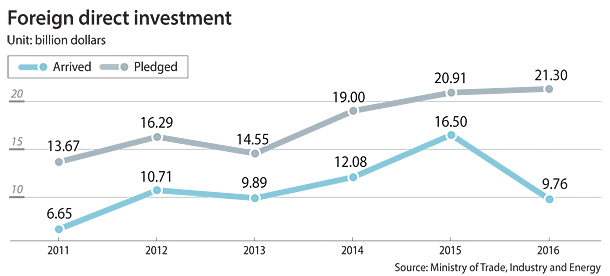FDI pledged hits record, but less actually arrives

The amount of investment pledged to Korea has seen a steady rise for the past few years, except for a brief dip in 2013 when the figure fell below $15 billion. It then quickly recovered, topping $20 billion in 2015 and rising 1.9 percent the following year, according to a report by the Ministry of Trade, Industry and Energy.
Manufacturing investment kept up its solid pace of growth, expanding 12.4 percent to $5.13 billion. But it was the service industry that led the charts last year.
Capitalizing on a growth trend since 2011, investment pledged from abroad for the service industry last year stood at $15.51 billion, up 5.3 percent from 2015. The ministry reported that business services, especially, enjoyed lucrative promised investment, rising from $2.02 billion in 2015 to $3.71 billion last year.
By type, greenfield investment took up the largest portion of the pie, with $15.02 billion pledged by foreign companies looking to build their businesses in Korea from the ground up. “Investments intended to utilize Korea’s free trade agreement platform with other countries and to establish a global manufacturing hub have gone up,” the ministry said in its report.
But such expansive growth in promised investment might end up being fool’s gold. While over $21 billion was pledged in 2016, only $9.76 billion actually made its way to Korea, down $6.74 billion from 2015.
Out of $6.27 billion promised for merger and acquisition deals, only $3.29 billion entered Korea, $5.54 billion less than in 2015. The amount of pledged investment for M&As also was 7.8 percent lower than in 2015. Even green field investment arriving in Korea took a hit, sinking from $7.67 billion in 2015 to $6.47 billion in 2016.
“Regarding the decrease in foreign direct investment in M&As, it wasn’t a single factor that caused the fall,” a ministry official said. “The World Investment Report by the United Nations Conference on Trade and Development projected that cross-border M&As would fall in 2016 worldwide, and we believe this global trend also took its toll in the Korean market.”
The UN report said that “the expected decline of FDI flows in 2016 reflects the fragility of the global economy, persistent weakness of aggregate demand, effective policy measures to curb tax inversion deals and a slump in multinational enterprises profits.”
Still, the ministry assured that most of the promised investment would eventually make it onto Korean soil. “Foreign investors normally commit to long-term projects, which progress over one to three years,” said an official from the ministry’s investment policy division. “For instance, if a foreign company commits $100 billion for a project, it doesn’t pour in the entire amount instantaneously. Instead, the investment arrives in phases. This is why the figure fluctuates each year. What we need to watch for is the progression.”
The official added that foreign investors sometimes do back out of their commitments “due to their internal affairs or market conditions, but this has nothing to do with the arrived amount of foreign direct investment.”
BY CHOI HYUNG-JO [choi.hyungjo@joongang.co.kr]










with the Korea JoongAng Daily
To write comments, please log in to one of the accounts.
Standards Board Policy (0/250자)